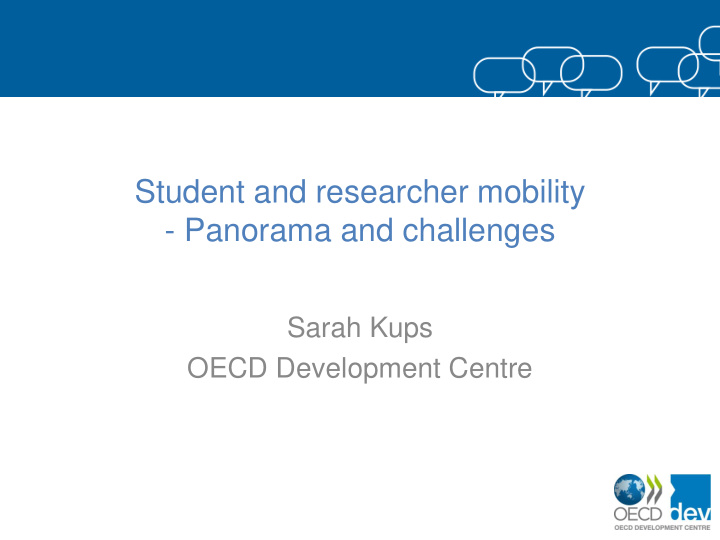



Student and researcher mobility - Panorama and challenges Sarah Kups OECD Development Centre
The number of mobile students is increasing Foreign students worldwide and in OECD countries, 2000-12 (Millions) 4.5 4.4 4.2 3.8 3.5 3.2 3.0 3.1 2.8 2.6 2.4 2.1 2.1 Worldwide OECD countries 1.6 1.6 1.9 2.1 2.3 2.4 2.4 2.5 2.6 2.8 3.2 3.3 3.4 1999 2000 2001 2002 2003 2004 2005 2006 2007 2008 2009 2010 2011 2012 Source: OECD (2015). International Migration Outlook. Underlying data Source: OECD Online Education Database, www.oecd.org/education/database.htm.
Africa’s students are highly mobile Share of enrolled students studying abroad Share studying within region % enrolled students studying abroad Share of mobile students within region 6 80 70 5 60 4 50 3 40 30 2 20 1 10 0 0 North America Latin America and the South and West Asia Central and Eastern East Asia and the Arab states Western Europe Sub-saharan Africa Central Asia Caribbean Europe Pacific Source: UNESCO Institute for Statistics
… and researchers are highly mobile as well East Africa South Africa Southern Africa West and Central Africa 70 60 50 40 30 20 10 0 Sedentary Outflow Transitory Inflow Source: Blom, Lan and Adil. Sub-Saharan African Science, Technology, Engineering, and Mathematics Research – A decade of development . World Bank: 2016.
Opportunities and challenges of scientific mobility o Scientific mobility can benefit the students and researchers themselves as well as their countries of destination….
Opportunities and challenges of scientific mobility o Scientific mobility can benefit the students and researchers themselves as well as their countries of destination …. o … but also their countries of origin, even if they choose not to return
Opportunities and challenges of scientific mobility o Scientific mobility can benefit the students and researchers themselves as well as their countries of destination …. o … but also their countries of origin, even if they choose not to return o However, studying abroad may be the only possibility rather than an active choice for some
Policies that can increase scientific mobility o OECD countries have pursued a variety of policies to increase scientific mobility ( OECD Science, Technology and Industry Outlook 2014 ) Financial incentives Mutual degree recognition Simplified visa processes and/or post-study work rights
Policies that can increase scientific mobility o OECD countries have pursued a variety of policies to increase scientific mobility ( OECD Science, Technology and Industry Outlook 2014 ) Financial incentives Mutual degree recognition Simplified visa processes and/or post-study work rights • Such policies can also be found elsewhere (e.g. Southern African Development Community)
Policies that increase scientific mobility o OECD countries have pursued a variety of policies to increase scientific mobility ( OECD Science, Technology and Industry Outlook 2014 ) Financial incentives Mutual degree recognition Simplified visa processes and/or post-study work rights • Such policies can also be found elsewhere (e.g. Southern African Development Community) • Several countries with large scientific diasporas provide career planning and financial incentives for return
Thank you for your attention Sarah.kups@oecd.org
Recommend
More recommend